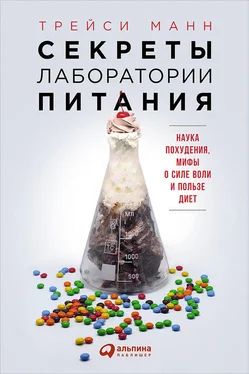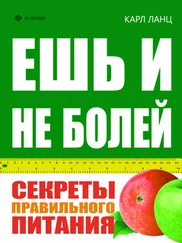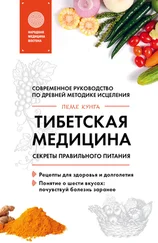Этим коллегой был Эндрю Уорд.
T. Mann and A. Ward, «Forbidden Fruit: Does Thinking about a Prohibited Food Lead to Its Consumption?», International Journal of Eating Disorders 29, no. 3 (April 2001): 319–27; в дополнение к этому: эксперименты с участием детей показали, что юные испытуемые едят запретный продукт в течение лишь первых пяти минут. Esther Jansen et al., «From the Garden of Eden to the Land of Plenty», Appetite 51, no. 3 (2008): 570–75.
Shelley Taylor, «Health Psychology», 8th ed. (New York: McGraw-Hill, 2011).
Все, что я рассказываю о стрессе в этом и следующем абзацах, подробнее описывается в замечательной книге: Robert Sapolsky, «Why Zebras Don't Get Ulcers», 3rd ed. (New York: Holt Paperbacks, 2004).
Pamela M. Peeke and George P. Chrousos, «Hypercortisolism and Obesity», Annals of the New York Academy of Sciences 771, no. 1 (December 1, 1995): 665–76, doi:10.1111/j.1749–6632.1995.tb44719.x; P. Björntorp, «Do Stress Reactions Cause Abdominal Obesity and Comorbidities?», Obesity Reviews 2, no. 2 (May 1, 2001): 73–86, doi:10.1046/j.1467-789x.2001.00027.x.
C. Greeno and R. Wing, «Stress-Induced Eating», Psychological Bulletin 115 (1994): 444.
Stephanie M. Greer, Andrea N. Goldstein, and Matthew P. Walker, «The Impact of Sleep Deprivation on Food Desire in the Human Brain», Nature Communications 4 (August 6, 2013): 2259, doi:10.1038/ncomms3259.
Rachel R. Markwald et al., «Impact of Insufficient Sleep on Total Daily Energy Expenditure, Food Intake, and Weight Gain», Proceedings of the National Academy of Sciences of the United States of America 110, no. 14 (April 2, 2013): 5695–5700, doi:10.1073/pnas.1216951110.
A. Janet Tomiyama et al., «Low Calorie Dieting Increases Cortisol», Psychosomatic Medicine 72, no. 4 (May 2010): 357–64, doi:10.1097/PSY.0b013e3181d9523c.
A. Janet Tomiyama et al., «Low Calorie Dieting Increases Cortisol», Psychosomatic Medicine 72, no. 4 (May 2010): 357–64, doi:10.1097/PSY.0b013e3181d9523c.
Diana E. Pankevich et al., «Caloric Restriction Experience Reprograms Stress and Orexigenic Pathways and Promotes Binge Eating», Journal of Neuroscience {dec63} 30, no. 48 (December 1, 2010): 16399–407, doi:10.1523/JNEUROSCI.1955-10.2010.
Из высказываний Джеффри Фридмана: Kolata, Rethinking Thin , p. 125.
В сорбете, как правило, содержится меньше сахара и углеводов, чем во всех остальных видах мороженого, но эта разница незначительна, поэтому он вам не помощник, если вы хотите сократить потребление сахара и углеводов.
K. D. Brownell and K. B. Horgen, «Food Fight: The Inside Story of the Food Industry, America's Obesity Crisis, and What We Can Do About It» (Chicago: Contemporary Books, 2004). Браунелл называет такие условия «токсичной пищевой атмосферой».
О том, что потребление жиров и сахаров только усиливает в человеке потребность в жирах и сахарах, и о том, как пищевая индустрия извлекает из этого выгоду, можно прочитать в работе: D. A. Kessler, «The End of Overeating: Taking Control of the Insatiable American Appetite» (Emmaus, PA: Rodale, 2009).
John P. Foreyt and G. Ken Goodrick, «Living Without Dieting» (New York: Grand Central, 1994).
Вопросы, наиболее часто используемые для оценки уровня самоконтроля, можно найти в работе: J. Tangney, R. Baumeister, and A. Boone, «High Self-Control Predicts Good Adjustment, Less Pathology, Better Grades, and Interpersonal Success», Journal of Personality 72, no. 2 (2004): 271–324.
M. Friese and W. Hofmann, «Control Me or I Will Control You: Impulses, Trait Self-Control, and the Guidance of Behavior», Journal of Research in Personality (2009).
Они проделали более серьезную работу, чем мы, поэтому результаты их исследования попали в печать, а наши никогда не публиковались: Denise T. D. de Ridder et al., «Taking Stock of Self-Control: A Meta-Analysis of How Trait Self-Control Relates to a Wide Range of Behaviors», Personality and Social Psychology Review 16, no. 1 (February 1, 2012): 76–99, doi:10.1177/1088868311418749.
Brandon J. Schmeichel and Anne Zell, «Trait Self-Control Predicts Performance on Behavioral Tests of Self-Control», Journal of Personality 75, no. 4 (August 2007): 743–55, doi:10.1111/j.1467–6494.2007.00455.x.
Walter Mischel and Ebbe Ebbesen, «Attention in Delay of Gratification», Journal of Personality and Social Psychology 16, no. 2 (1970): 329–37.
Для ознакомления с результатами исследования стресса и фрустрации см.: W. Mischel, Y. Shoda, and P. K. Peake, «The Nature of Adolescent Competencies Predicted by Preschool Delay of Gratification», Journal of Personality and Social Psychology 54, no. 4 (April 1988): 687–96. Обобщение целого ряда экспериментов по аналогичной теме представлено в работе: W. Mischel, Y. Shoda, and M. Rodriguez, «Delay of Gratification in Children», Choice over Time (New York: Russell Sage Foundation, 1992), 147–64.
Индекс массы тела – это показатель, позволяющий оценить степень соответствия массы человека и его роста.
Tanya R. Schlam et al., «Preschoolers' Delay of Gratification Predicts Their Body Mass 30 Years Later», Journal of Pediatrics 162, no. 1 (January 2013): 90–93, doi:10.1016/j.jpeds.2012.06.049. Сам факт того, что существует некая связь, прослеживающаяся и спустя 30 лет, примечателен, однако тесты с отсрочкой вознаграждения объясняют различия массы тела испытуемых лишь в 4 % случаев, в остальных 96 % действуют иные факторы.
В других исследованиях ученые использовали аналогичные тесты и также обнаружили относительно слабую связь. Как только находились наиболее характерные переменные, те исчезали. Например, в этом исследовании можно проследить сначала едва обнаруживаемую связь, потом связь еще более слабую, а потом и полное ее отсутствие. Lori A. Francis and Elizabeth J. Susman, «Self-Regulation and Rapid Weight Gain in Children from Age 3 to 12 Years», Archives of Pediatrics & Adolescent Medicine 163, no. 4 (April 6, 2009): 297–302, doi:10.1001/archpediatrics.2008.579; Angela L. Duckworth, Eli Tsukayama, and Andrew B. Geier, «Self-Controlled Children Stay Leaner in the Transition to Adolescence», Appetite 54, no. 2 (2010): 304–8; Desiree M. Seeyave et al., «Ability to Delay Gratification at Age 4 Years and Risk of Overweight at Age 11 Years», Archives of Pediatrics & Adolescent Medicine 163, no. 4 (April 6, 2009): 303–8, doi:10.1001/archpediatrics.2009.12.
Читать дальше
Конец ознакомительного отрывка
Купить книгу












